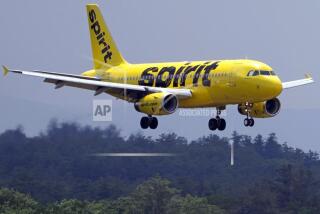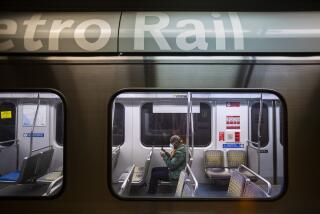Greyhound Emerges From Bankruptcy With New Look : Transportation: The only national intercity bus line still has problems, but it also has newer fleets, cleaner terminals and better service.
DALLAS — Greyhound Lines Inc. President Frank Schmieder spent his July 4 weekend riding incognito on the company’s buses, his way of personally assessing changes implemented since Greyhound emerged from bankruptcy.
While he did not always like what he saw, Schmieder said in an interview Monday that the rides on Greyhound have given him a firsthand look at the company’s better service, cheaper fares, newer bus fleets and cleaner terminals.
“We haven’t got all the problems solved, but we’re getting there,” Schmieder said.
The Amtrak rail strike and special fares have helped Greyhound. But Schmieder said the Los Angeles riots and fare-cutting by airlines hurt the bus company in its second quarter.
Revenue dropped nearly 7% to $153 million in the three months that ended March 31. But the operating loss of $615,000 was well below the $8-million loss reported for the same period a year ago.
After the April verdict in the trial against four police officers involved in the beating of motorist Rodney King, the company was forced to close terminals and curtail service to several California cities because of rioting and looting.
Traffic also dropped in cities such as Atlanta and Las Vegas.
Half-price airline fare promotions introduced in late May also cut into Greyhound’s business. Schmieder said he expects the negative impact to continue through mid-September, the last effective dates of the fares.
But there were positive events in the second quarter as well, he said.
In April, Greyhound moved to improve profit by reducing debt. The company sold $99 million in subordinated notes, using proceeds to pay off $55 million in high-interest bank loans.
Last month, Greyhound accepted Amtrak tickets from passengers stranded by the two-day nationwide rail shutdown.
“There was an immediate impact, but it wasn’t as dramatic as one might think because it didn’t last very long,” Schmieder said.
Greyhound used the opportunity to reap long-term gains by surveying Amtrak customers to find out why they didn’t ride the bus in the first place.
Schmieder said Greyhound is still working to improve the tense labor relations that pushed the company into bankruptcy.
Greyhound, the only national intercity bus line, bears little resemblance to the company that plunged into bankruptcy in June, 1990, during a bitter nationwide labor strike.
It has cut more than 72 million miles of unprofitable routes, trimmed its staff of bus drivers by 2,000 to 3,725 and eliminated 900 older buses and 474 leased vehicles from its fleet.
In January, the company introduced its first discount fares to boost ridership during a traditionally slow season. It followed that in June with “Summer Money Savers,” offering customers as much as 50% off full fares, with 14-day advance purchases.
“When we announced the new promotion, our call volume jumped from 11% below last year to 14% above last year,” Schmieder said.
Wall Street analysts who follow Greyhound said they are impressed by the company’s actions.
“I think they’ve made tremendous headway in putting the company on a very profitable footing,” said Jan Loeb, an analyst with brokerage Legg Mason in Baltimore.
More to Read
Inside the business of entertainment
The Wide Shot brings you news, analysis and insights on everything from streaming wars to production — and what it all means for the future.
You may occasionally receive promotional content from the Los Angeles Times.










